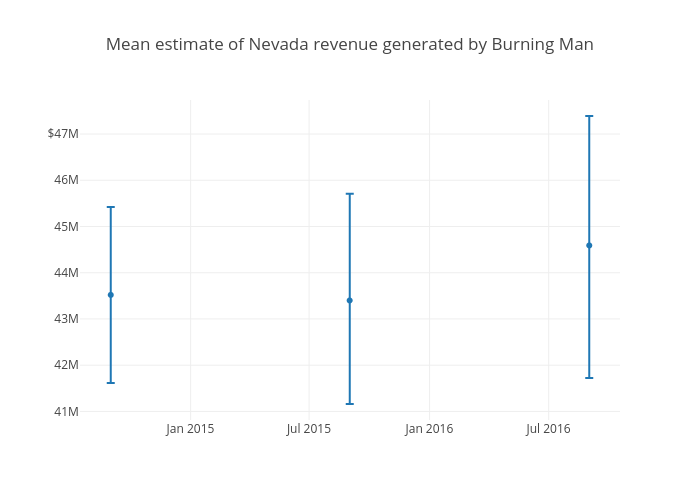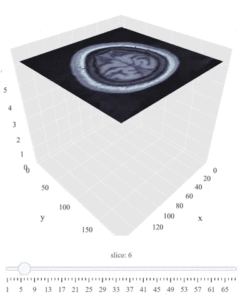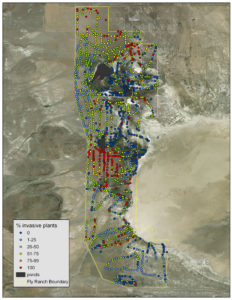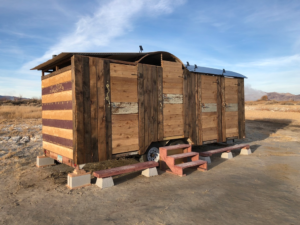Fly Ranch Project
12-Month Roadmap
April 2018
We all have different views of what Fly Ranch could become: a healing center, a desert art center, an energy park, an organic farm, a botanical garden, a site for interactive teaching and learning, a Burning Man laboratory, a makerspace, a space for transformative gatherings, a sustainable model for communal living, and more. Our 3,800 acres holds diverse ecosystems and varied resources, so the future could involve some blend of these and other visions.
The Fly Ranch team spent 2017 building momentum and capacity. We held community conversations in Black Rock City, at the Global Leadership Conference in Oakland, and Burning Man Project’s European Leadership Summit in Stockholm, Sweden. We were able to welcome 400+ community members, collaborators, artist, regional contacts, and local citizens to explore the property with us. We began a Land Fellowship program and a year-long environmental assessment, including an inventory of flora and fauna of the property. We’ve integrated our administrative operations with Burning Man Project and created an operationally effective working group and management team. We’ve started laying the groundwork for our technical operations. We re-launched our website with over 40 pages of content.
2018 will be a year of putting capacity into action. We will be deploying open-source technology tools for sharing information about the property and for anyone to participate in proposing, discussing, and collaborating on projects for the site. In April, the gates of Fly Ranch opened to the public as we began hosting open days for locals, leave no trace trainings, field trips for schools, and a Nature Walk program in collaboration with Friends of Black Rock-High Rock, a local conservation group. During the Summer, we will start to experiment with small group trips and overnight visits. We will clean the property and undertake key infrastructure projects like a small solar grid, composting systems, and walking pathways through a series of experiential community workshops.
To get from our current place to the loftier possibilities, we’re planning on the community testing small versions of different visions to see what works. We will face real problems and learn from them. Some of these experiments have already begun: you can join a nature walk, become a Walk Guide, or volunteer as a Fly Ranch Guardian.
This document is an overview of our current work and where we hope to go in the next 12 months. This plan, like the project, is a work in progress and the only guarantee is that some things will inevitably change. We have tried to make it clear where there are still questions remaining and where concrete plans differ from hopeful ambitions.
1. Vision
As a community, we’ve become very good at “doing Burning Man” for a week at a time. Every year, we come together in a harsh landscape to build the world’s greatest DIY city. How would things be different if we wanted to create a Burning Man experience that didn’t disappear in a week, but instead lasted for months, years, or even generations? How would this change our needs for considering infrastructure, finances, decision making, and social interactions? What new opportunities does this present to exponentially increase Burning Man’s impact on the world? The Fly Ranch Project is our collective opportunity to answer those questions.
Survival in a scarcity-driven world requires us to be consumers, participate in capitalist markets, and rely on nationalized or privatized grids, utilities, and networks. If people could exist in cooperation with the environment while meeting their basic needs, creativity could flourish and new ideas could be fostered without the constraints of “the way things are”. Fly Ranch serves as a test site to prototype methods for this type of radical self-reliance and self-expression for both the Burning Man community and the wider world. Our remote desert landscape is scalding in the summer, frozen in the winter, and flooded for portions of each year. We don’t have power, plumbing, cellular coverage, or shelter. This lack of infrastructure, current resources and remoteness make it a perfect place for a living laboratory to explore new solutions and creative ideas for community, art, sustainability, architecture, closed-loop systems, and agriculture, as well as personal and interpersonal development.
If we can do it here, it can be done almost anywhere.
Like Black Rock City, our organization’s focus is on creating a container and then empowering and inviting others to fill that space with their ideas. Eventually, we generate shelter, water, composting, energy, and food all from our immediate environment. The Burning Man community, we believe, is brimming with unrealized potential. We want to catalyze the incredible passion and creativity in our midst and give it a new platform for inspiring the self, the community, and the world.
This is an ambitious undertaking and one that will take time, experimentation, collaboration, and a fair amount of trial and error. It won’t be easy, but we’re Burners. Doing difficult things in inhospitable places is kind of our specialty.
2. Goals
In the next 12 months, we have five broad goals:
-
Open Fly Ranch for Public Access
This year, for the first time in decades, Fly Ranch will be openly available for access by the public. Starting in March, we will host Nature Walks a few times a week. At the outset, these walks will be facilitated by the Friends of Black Rock-High Rock, a local conservation group. We held a training program in March for community members who want to become guides for these walks, a model similar to BRC Rangers or Lamplighters. Once walks are established, we will experiment with small group trips and overnight visits in April as we undertake initial infrastructure projects. This includes clean up weekends, locals days, and science-based education trips.
-
Clean Property and Begin Deploying Key Infrastructure
Fly Ranch is covered in relics from its former uses like homesteading, hunting, aviation, and the 1997 Burning Man event. We have a responsibility to clean the property, and starting in April we will host a handful of clean-up days in partnership with Burners Without Borders to begin this process. We also have needs for some initial infrastructure projects like small solar grids, composting systems, and walking pathways that will be developed through community events.
-
Develop Open Source Platform as a Cornerstone Communications Tool
We will be deploying open-source technology tools for sharing information about the property and for anyone to participate in proposing, discussing, and collaborating on projects for the site. This will be the core tool for remotely interacting with the project and others in the community.
-
Prioritize Environmental Stewardship and Initiate Research Partnerships
Can we build closed-loop ecosystems where we generate and recycle food, energy, art, fire, and water? How can experiments at Fly Ranch create sustainable solutions for Black Rock City and beyond? We want to start to explore these questions by continuing thorough research of the property, making this information readily available, and engaging in a wide range of scientific and research partnerships with leaders from a wide range of disciplines.
-
Begin Crafting a Long-Term Vision for the Project
Once inclusive and transparent access to the property is available to the public, and the community has more information about the state of the land, we can begin a meaningful long-term visioning process. We will begin initiating these conversations online, in-person, and onsite at Fly Ranch.
Here is a rough visual summary of our plans for the year:

3. Budget
The Fly Ranch project is currently funded through donations. While we are excited to explore a variety of models for future financial sustainability including site usage fees, agriculture, workshops and memberships, our 2018 budget is dependent on generous gifts from those who see and believe in the promise of Fly Ranch.
Our 2017 budget for the project was roughly $350k. Our expenses came in below that. We are committed to managing expenses closely, and to spending money strategically and intentionally. Our hope is to again come in under budget for 2018.
We can fundraise to meet our needs through relationship development, public support, and events. Our projected 2018 budget is roughly $350k. $200k of this is for staffing and contractors. $60k is on site infrastructure, materials, and construction. The remaining $40k is for event production, travel, and administration. This budget allows us to continue our current rate of development, initiate site improvements and open source tech development, and begin public access. This roadmap lays out what we hope is possible within this budget.
Being transparent about our budget is important to us. People who donate will want to know what they are supporting. Transparency is valuable for enabling participation, building trust, raising money and receiving feedback.
In addition to economic sustainability for the project, a chief goal of ours is to support an ongoing sustained economic and cultural benefit to the Gerlach area. The economic impact to Northern Nevada as a result of Burning Man (see below) is substantial, but all occurs all at once. We’re hopeful that year-round activities at Fly Ranch will help create public benefit, and a sustained influx of visitors that can support local food, lodging, and recreation businesses without bottlenecking systems and civic services.

4. Operating Structure
The true power of Burning Man lays in the diverse and impassioned contributions of a wide, diverse, and highly dedicated community. Given the potential scale and diversity of the Fly Ranch project, it is important to have a structure that lets us discuss complex topics and supports the community to organize around projects. Burning Man is a real world choose your own adventure, in part because people are empowered to follow their passions and contribute their unique gifts. We hope Fly Ranch can be something similar during the other 51 weeks of the year.
A constraint on our current process is the ability to scale. More people want to be involved than a team of two can directly and meaningfully engage with given the current tools at our disposal. So far over 3,000 people have signed up to volunteer with Fly Ranch through our Participation page. We’ve begun interviewing for a Volunteer Coordinator to help develop volunteer-led teams based around areas of interest such as communications, operations, technology, and many of the areas of focus listed in this roadmap. To help us scale involvement in 2018, we will rely on technology like Google Docs, Slack, project management tools, and discussion forums to support peer to peer connections.
These teams will help the project address complicated questions across diverse disciplines that require expertise, research, and discussion. These areas include water, zoning, ecology, architecture, permitting, technology, politics, engineering, art, and so much more. Like Black Rock City, our organization’s role is primarily that of creating a context that supports and nurtures people’s individual projects and ideas. We are a platform, not the producers. We don’t expect that “Fly Ranch will be doing something” but instead camps, artists, and organizations will be “doing something at Fly Ranch.”
With the support of the Burning Man organization and soon volunteers, our team is managing core operational functions that are focused on bringing people out to the property in appropriate and sustainable ways. As the project develops, how will people with experience and interest in art, civics, environment, and other disciplines help influence the development of the Fly Ranch project?
One option we are considering is to create a multidisciplinary visioning body to give advisory input, perspectives and feedback. An advisory team composed of community members with expertise in zoning, water, building code, event permitting, and art could help advance work rapidly with a vast wellspring of knowledge to draw upon.
5. Zoning
Fly Ranch is zoned for General Rural in High Desert Area, a fairly permissive tier. Potential activities fall into roughly three categories: Allowed (either things that we can do how we please or do with a simple inspection), Allowed with Permit (either a basic administrative permit or, for larger projects, a special use permit) and Not Allowed. Below are some of the most relevant examples of activities permitted within the first two of these categories:
Allowed: |
Allowed with Permit: |
Residential Housing (1 house/40 acres)
|
Automotive Repair
|
These zoning restrictions will be an important framing for the conversations to happen in 2018 geared towards developing a long-term vision and initiating early projects that community members wish to undertake. Rezoning, even by individual parcel, is possible but takes years, and there is certainly a lot to do in the meantime.
Additionally, Fly Ranch is currently the recipient of a tax benefit because it is used for agricultural purposes. We need to continue to fulfil our obligations (see: NRS 361A) that allow us to receive a benefit or pay back taxes on the property. Currently, this use is cattle grazing but could end of being lots of different things else beekeeping or crop cultivation.
6. Public Access
Starting in April, we began welcoming people who are interested in the project to join us for walks on the Fly Ranch property. We will begin, with one foot in front of the other, to find our path forward with this project.
Why start with walking? These walks will be a collective learning experience. For us to begin an inclusive and effective planning process with participation from Burning Man community, a diverse range of experience and opinions should be represented. So, we’re going to start walking for a few hours each week in small groups. You can sign up for the walks on the reservations page.
Friends of Black Rock-High Rock are partnering with us to help manage the logistics of these walks, as they have many years of experience bringing folks out to the Northern Nevada high desert. We experimented with this model at the end of 2017 and have developed a program that is capable of welcoming thousands of visitors over the course of 2018, in a culturally and environmentally appropriate way. We have seen erosion on the edges of the pools already. We are beginning to explore alternative methods for allowing soaking. In the meantime, we are not able to accommodate soaking in the pools during walks.
We are implementing a community training program similar to the Black Rock Rangers, where anyone who is interested, reads our guide, and commits to a training can help facilitate these walks. This is how we will scale our capacity. Once we are comfortable with walks, we will begin to experiment with small events, group trips, and workshops.
We have also begun planning locals-only days. Northern Nevadans have been enjoying the hot springs for generations and we want to help preserve that tradition. We’ve even been brainstorming some fun ideas like town BBQs or pop-up movie nights on site. Jaws, anyone?
These regular activities will help us mitigate trespassing issues. Fly Ranch sees would-be trespassers regularly. As the space becomes more active and well-known, drop-by visits will increase, and a continual onsite presence will become a requirement.
Also starting in Spring, Burners Without Borders will be hosting the first of our Fly Restoration weekends where we can begin to clean and slowly improve the environment at Fly Ranch. These work weekends will be an exciting opportunity to put boots on the ground and start helping to shape the property and project.
A question that remains is: if we were going to open the property to other groups who wanted to host events aligned with the Ten Principles, how should we administer those events? What organizations or companies are appropriate for us to affiliate with and which are not? What would the revenue structure look like for these kinds of engagements, and who would be invited?
7. Technology
As much as possible, we will use open source software in our projects. Using open source software lets us avoid vendor lock-in. We can edit, control, combine, and alter our software. We have started in this direction. We recently completed a review of discussion software and selected Discourse. We solicited feedback from the technical team, stakeholders, maintainers of different technology platforms. We will continue to use this same strategy for future projects.
Short-Term Goals:
We have short-term goals for a base technology infrastructure. The timing estimates below are rough.
-
Discussion software (3-4 mo). We will be using Discourse for this, and hope to answer these questions.
-
Decision-making software for presenting and evaluating ideas together (12-18 mo.). Examples of this include Loomio and Ethelo. These tools will let us assess specific ideas like parcel-by-parcel proposals, art, or energy projects.
-
Internal and external project management software (12-24 mo.). We’re examining OpenProject for this.
If you are interested in our technical hopes for Fly Ranch and the greater Burning Man Project, we urge you to read the Fly Ranch Technology Roadmap. These projects will take years to complete, but we want to start off in a direction that allows us to achieve our long-term goals. Above all else, our guiding vision is to build an open-source platform that lets Fly Ranch engage our community, make decisions, and self-organize for participation as a community.
8. Communications
Opening Fly Ranch to visitors in the Spring, combined with a new website and development of a discussion platform, will create a new level of attention from the public, community organizations, and media. Because this project is in its infancy, the conversations had amongst these groups will have a significant impact on the perception and trajectory of the project. We are committed to our communications being proactive, transparent, informative, and consistent with our principles.
We will increase our communications through Burning Man’s official website and social media channels, as well as take advantage of opportunities to share the project with external partners and appropriate media outlets. Our website will be updated regularly and the Fly Ranch Newsletter will increase from quarterly updates to monthly. The number of voices sharing posts on the Burning Man Journal related to Fly will expand, and we will be creating a dedicated Fly Ranch Instagram feed to showcase the stunning images and being collected of the plants, animals, the day-to-day progress, and activities on the property. A presentation we’ve made can be used to discuss and facilitate talks about the project.
As we continue to learn about the plants, animals, parcels, and weather of the Fly Ranch property, we want to prioritize communicating this information in engaging ways. Leveraging the technology infrastructure above, we have identified some nifty projects we would like to either scope or begin working on in 2018:
-
High-res 3D mapping (6-12 mo). This would require aerial photography. Once the map is complete, we can have map layers for elevation, moisture, plant life, animal sightings, and proposed projects.

-
Discussions directly on interactive maps, graphs, and apps (6-12 mo). People could explore maps and browse comments on parcel-by-parcel discussions on each of our 53 parcels. We can already start this using Google Maps.
-
Real-time data displays (24-36 mo). We could have dashboards monitoring wind turbines, solar arrays, compost pile temperatures, bee activity, water temperature, geyser pressure, water production, ecological art projects, and more. We could live-stream data to enable anyone to explore our projects and get involved. If we plan to build closed energy loops, we’ll need to carefully monitor and understand how much energy we gather and use.
-
Record and display environmental cycles (24-36 mo.) We could set up sensors to monitor water levels and flow (e.g., Arduino or Raspi) and display movement, soil readings, migratory patterns, and more in 3D animations, like the 3D brain visualization below.
-
Explore 2D and 3D visualizations of the composition and genetic sequencing of water, air, and soil (24-36 mo.). Documenting our resources would let us explore and discuss the land as we research what energy and water projects are best suited for the land.
These tools can make our project inclusive, engaging, and accessible to just about anyone. We want our website to be a comprehensive, and yet still consolidated view of our project. In under a minute, someone could explore our property, proposals, see the history of the discussion, see who was involved, interact with maps and videos, then claim a task they are suited for. People could connect with like-minded individuals through ideas and then become collaborators.
9. Environmental Planning
In April 2017, we began hosting a year-long Land Fellowship as part of Burning Man Project’s Fellowship Program, an initiative that has been investing in people and innovation within the Burning Man community. With degrees in Ecology and Botany, a Ph.D. in Environmental Science, and years of experience in DPW, Lisa “Scirpus” Schile-Beers was found to be uniquely suited to explore and evaluate the property and was selected as our first Land Fellow. In the first 8 months of the Fellowship, Lisa has undertaken an inventory of flora and fauna, catalog of human-made objects onsite, a blog series on the Burning Man Journal, and much more that has helped our project start with a strong baseline understanding of the state of Fly Ranch.

A cataloging of invasive species found at Fly Ranch.
We are not on the grid. Thankfully we have abundant access to solar, wind, and geothermal power resources, if they can be harnessed. We can gather biomass and biofuel. With solar panels and transmission lines, we could power Fly Ranch, BRC, and more. We have wells, springs, geysers, and pools. We can use the water for drinking, swimming, heating, cooking, and more. If we put in a small treatment facility, we could provide water and ice for Gerlach, Fly Ranch, or BRC. We are inspired to explore the potential for creating sustainable solutions and ecological closed loop systems. We have some work ahead of us in terms of research on zoning, resource inputs, building codes, and legislative regulations, but eventually, we can create energy, clean water, economic growth, and recreation. For example:
-
Geothermal power and lithium from pools to make batteries for cars or homes
-
Solar power to convert carbon dioxide into sustainable energy
-
Natural, sustainable refrigeration techniques for preserving food and making ice
-
Harvesting water from the air, catching rainwater or cleaning geyser water
-
Bioenergy (biofuel and biomass) powered machines, vehicles, and art projects
-
Greywater and compost projects with Gerlach, Reno, and Black Rock City
-
Wind to power wireless internet and coverage for the surrounding county
-
Raise bees to support a native nursery with hydroponics and aquaponics
-
Housing projects, makerspace, and research center powered by a solar roofs

 Composting Systems:
Composting Systems: